Paul Cezanne is one of the most influential artists of all time and he is considered to be the father of modern art. His work has a significant impact on many artists who came after him. Like Claude Monet, one of his contemporaries, he often painted series on the same theme. And among all, The Card Players by Paul Cézanne became the masterpiece.
By the way, The Card Players is not one painting rather it is a series containing several pieces on the same theme. Cézanne painted this series between 1890 and 1896 and there are five of them. Moreover, these are oil on canvas paintings that represents impressionist theme.
During the exhibitions of this masterpiece series, Cézanne’s personal life was more than paradoxical. On the one hand, critics, art dealers, and audiences kept refusing his works. But the rare times, when he showed them at Impressionist exhibitions, he got mixed reviews.
For example, he won the words of the critic Georges Rivière a “success of giggles”. On the other hand, a small group of amateurs, critics, and artists, like Maurice Denis and the Nabis showed him respect. And that happened when they discovered his paintings in the shop of Father Tanguy, a color merchant whom Cézanne has long paid his debts in paintings.
Though Cézanne was not widely popular during his lifetime, he got his recognition at a later age. After all one of the paintings among The Card Players series is one of the most expensive paintings in the world today. In particular, that is the third most expensive painting ever auctioned.
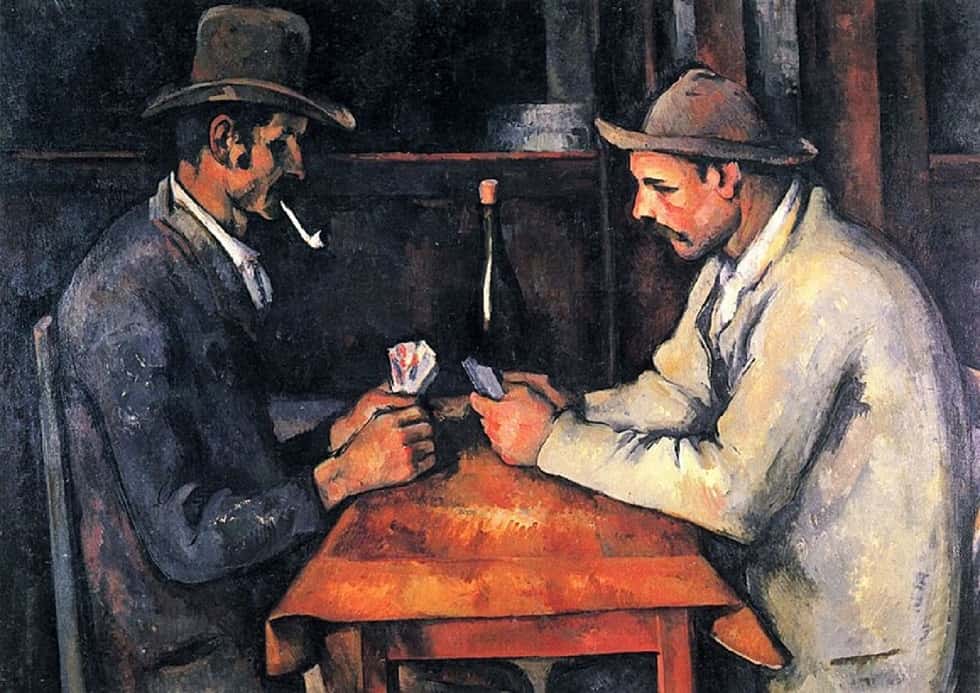
The Card Players by Paul Cézanne: Rise of a Master Artist
Critics and artists started to recognize Paul Cézanne in the 1890s. And his life and arts turn into success. At the beginning of the period, he starts getting invitations to exhibit his works.
In 1890, he was invited to showcase his work along with a small group of twenty artists in Brussels. During that time his work also appeared with positive articles. And Ambroise Vollard, a popular French art dealer becomes his dealer and offers him his first personal exhibition in a gallery. But among all of his arts, The Card Players snatched audiences and in particular, this series made him popular.
In 1895 Cézanne was living in retirement in his native Provence. There in Aix-en-Province, he had a family property of Jas de Bouffan. The place was increasingly isolated, and he led a life entirely devoted to his work. But he visited the Paris region time-to-time, and there he found his friends Renoir (painter of Bal du Moulin de la Galette), Monet, and Pissarro. After all, they all are painters belongs to the Impressionist period.
But at the same time, he distanced himself from his old childhood friend, Émile Zola. The reason for the distance was Zola’s L’Oeuvre, a novel published in 1886. In the novel, he recognized himself in the guise of the hero Claude Lantier, a failed painter. After that and due to some other reasons, Cézanne suffers from a radical lack of self-confidence.
Paul has a lot of accomplishments as a pioneer of few artistic movements including modernism, post-impressionism and cubism. Though Publo Picasso is the father of Cubism, Cézanne built the bridge between impressionism and Cubism. We can also say, that if Cézanne did not start the impressionist movement, modern arts like The Interchange by William de Konning wouldn’t see light so easily. To put it simply, impressionism changed the history of art and gifted us the era of modernism.
Critical analysis of The Card Players by Paul Cézanne
Cézanne’s Beliefs and Ideologies
Despite his artistic innovation, Cézanne remains conservative in his life and his ideas. The conservatism and his return to Catholicism were like a betrayal to the world of his origins. He shared that though everything was changing in reality, he was not. He believed that his age was the time to see his past by staying in the city of his childhood. Moreover, he liked all the aspects of people who never became violent and maintained customs by letting themselves go to the laws of time. But he hated the effort of that law anyway.
To Cézanne, the peasants are the living symbols of an ancestral world. And he is deeply attached to that symbol which we have also seen in his works. Moreover, they are the human equivalent of nature and ancient time which he never ceased to paint.
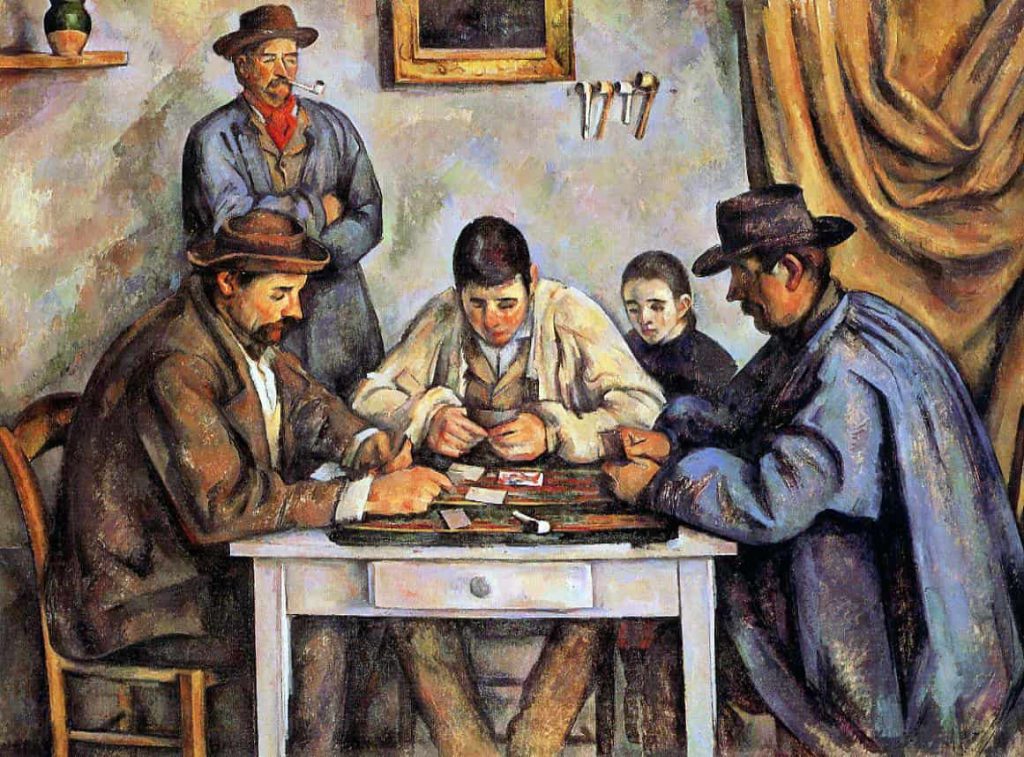
The Card Players by Paul Cézanne Inspired By 17th Century Paintings
The Card Players by Paul Cézanne is an art inspired by 17th-century paintings. For this series of paintings, he employed peasants at the Jas de Bouffan. He used his family estate for all the paintings. Besides, he hired peasants to pose separately and then assembled the different figures on the canvas.
The inspiration behind the Card Players was the city’s cafés. Moreover, he also took examples from the artistic traditions. And we can see that the theme of card players belongs to the classical period. This type of tradition was common in 17th-century painting. In addition, they had satirical and moralizing dimensions. Meaning, most often, painters portrayed gambling as associated with ideas of cheating, disorder, and bad living.
Probably Le Nain Brother’s paintings had a heavy influence on Paul since the Aix Museum displayed at that time. We find the similarities both in the subject and the serious internalized tonality which was specific to these painters. Moreover, these traits were also existent to the whole French realist tradition, up to Courbet and Manet.
The painting from the Card Players by Nain Brothers can reconfirm that The Card Players by Paul Cézanne had an influence on his works. This painting of Nain’s also had a similar name. Besides, it features four characters like a few of Cézanne’s paintings. According to classical iconography, the paintings symbolize the different ages of life, from childhood to old age.
So, we can clearly say that the dimension of painting (considerable for Cézanne:134 x 181 cm), and the complexity of the composition with five characters in the first version admits that he wanted to be a part of this great tradition of the 17th century.
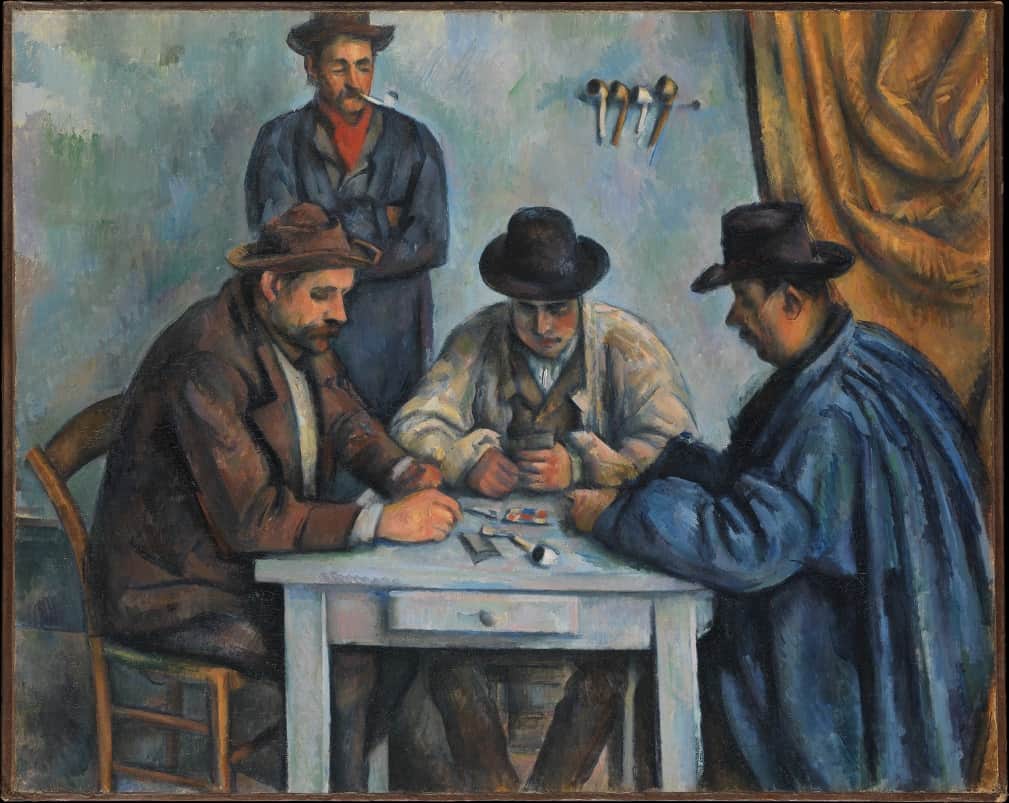
The Thematic Differences of The Card Players
The Card Players is composed of different themes despite having the same card-playing visuals. Among the five, 1890-92, oil on canvas, 65.4 x 81.9 cm painting depicts four people. And its genre scene also comes with the characteristic details of the pipe rack on the wall and it is stripped of all satire. Card game here portrays ‘honesty’, where the austerity of peasant life weighs heavily.
When it comes to the first version (in possession of Barnes Foundation, Philadelphia) of the painting, it refers to the ages of life which are maintained by the presence of a little girl and an elder. But the second version, the one hanging on the Metropolitan Museum, New York, is in a slightly tighter shot. There the artist has removed the child and replaced the young man in the center with an elderly man.
The last three paintings of the series are considered as later versions. And in these pieces, the artist finally, retains only two players. They are in a closer shot, and a wine bottle has replaced the person in the middle.
Variations in the Composition of Color and Space
The smallest one of the last three versions with 47.5 × 57cm dimension is currently in Musée d’Orsay, Paris. It is the most distinctive and recognized one and is often considered the last of the series. Most critics have also described it as the most refined and monumental painting of the Card Players series.
Another one of the last three with 60 x 73 cm dimensions is on display at The Courtauld Institute of Art, London. But the largest among the last three is in the private collection of the Royal Family of Qatar. The family purchased the painting for a staggering $250+ million from a Greek collector which makes this the third most expensive painting in the world.
When it comes to analysis, we have to think about the composition of the paintings first. And in the case of the Card players, it makes us consider the surrounding space immediately. In the paintings of London and Paris, the artist has abolished the surrounding space. And there is no longer a container occupied by bodily volumes but a surface rubbed with colors.
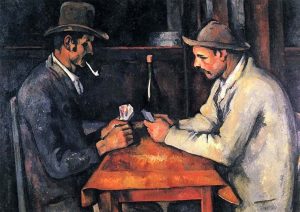
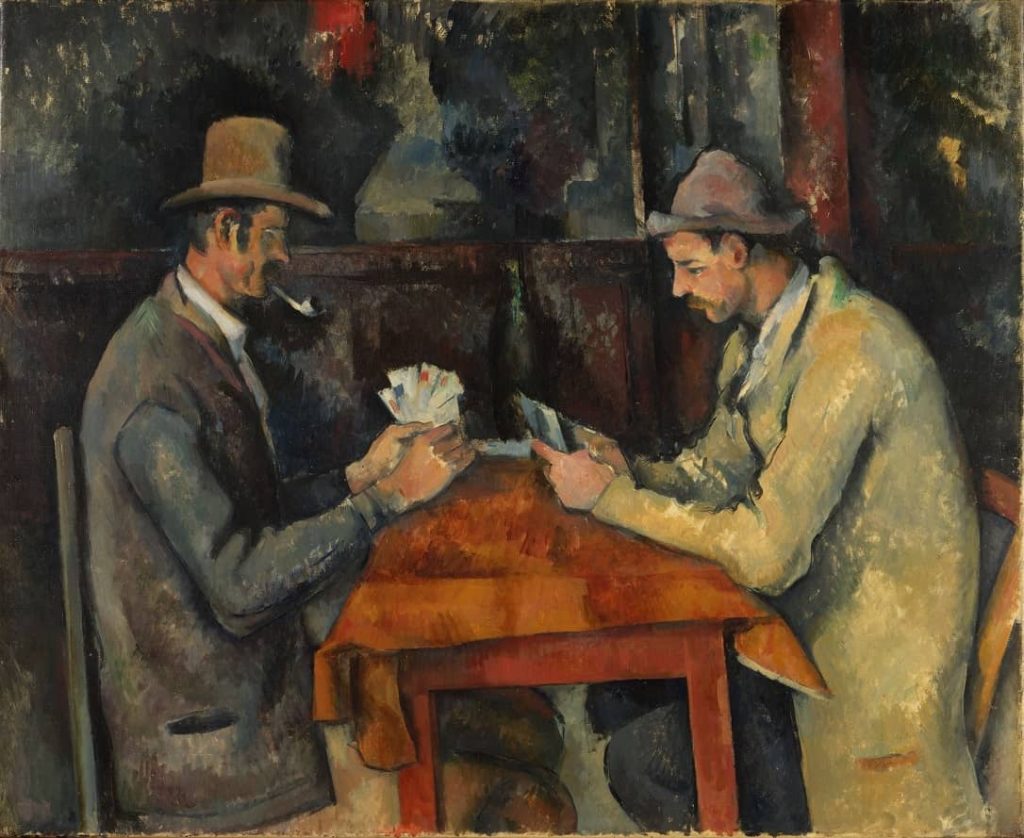
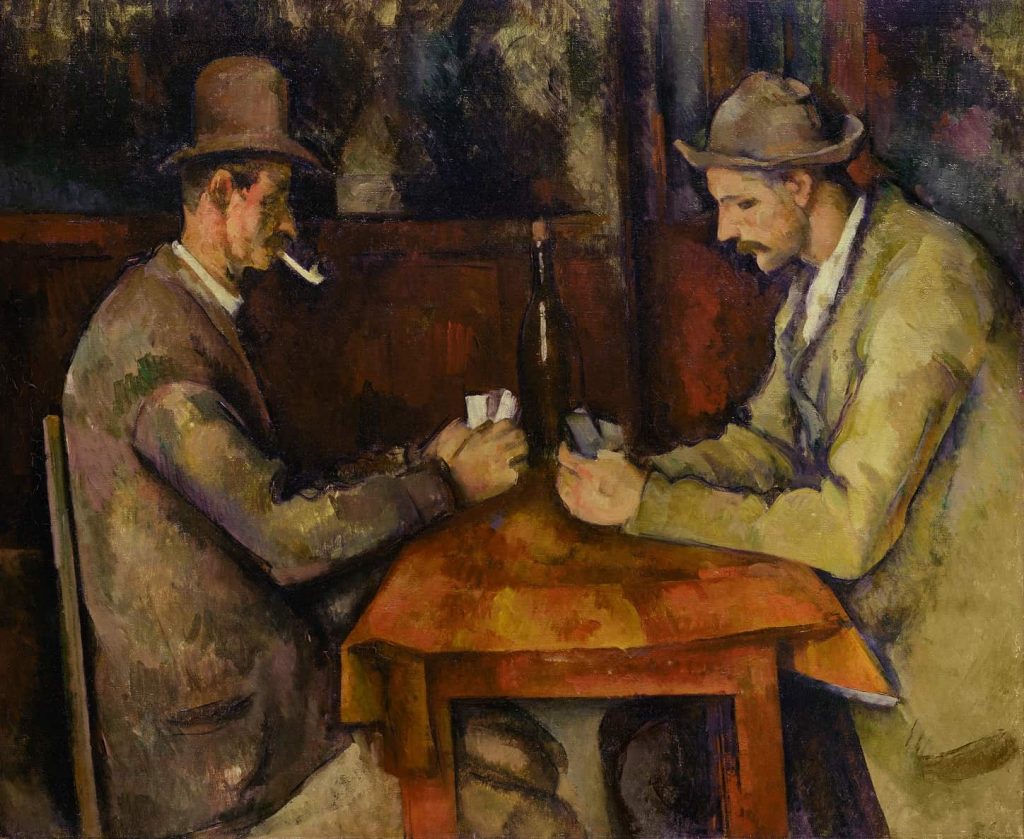
Moreover, the color brings the wall, a French window, and the woodworks to the conscious mind while the figures are not treated otherwise. Furthermore, the heavy volumes of these two versions recall the compact figures of the primitives. But they are given way to construction on the surface by the typically Cézanne game of juxtaposed directional keys.
In addition, the form is constructed by a succession of colored modulations which reverberate from one part to another which you see clearly from the jacket to the tablecloth, and from the faces in the background. To be precise, all elements and brushstrokes make the entire surface vibrate.
On the other hand, Cézanne has used a slightly different color composition for the largest of the last three. Here, all the details are slightly more visible with little dull pigments exposed to light, while reducing the sharpness of the details. The spacing is even tighter than the other two and the wine bottle looks sharper than all the other objects.
Significance of Symbols and Metaphors
Not to mention, The Card Players by Paul Cézanne is a series of impressionist arts, thus the use of symbols and metaphors are inevitable. From the first version to the last, there is a gradual reduction of space visible in bare eyes. The characters have reduced from five to two while the silent tension of the face-to-face dual confrontation increases. Therefore, the critics and audiences often question the symbolic and metaphorical significance of The Card Players series.
In the first two versions, the elderly man standing on the left, wearing a tall hard hat, pipe in the mouth seems to be a father figure. He is the symbol of assurance and authority here. Moreover, he is facing the younger man in the middle, with a gloomy face, and in a soft hat. Maybe the transposed and the father figure symbolize the conflict between Cézanne and his father. On the other hand, the wine bottle in the latter three versions can symbolize the line between competitors keeping an asymmetrical balance.
Another symbol is the card game itself. Though it remains weak, and implicit in the form, it can convey a strong message. Art critics often conclude that the card symbolizes the dignity, isolation, and solemnity of an ancient monument. In other words, they find a tomb. It is the tomb of the Cézanne Father and Son where their fate is at stake.
About the metaphorical representation, the card game played a very vital role here. At the time of Cézanne, the creation of modern painting was driven by the search for a certain primitiveness. And that primitiveness was often compared to playing cards.
If you look at the London painting, the colors of the cards are highlighted. They are visible almost in a naïve way. If we take this as a metaphor, it would refer to the very work of the artist. To be more precise, the artist composes his paintings with color by thoughtful touches, whereas a card player calculates the best possible combinations, with various methods.

The Card Players and The Cezanian Method
Throughout the series of the Card Players by Paul Cézanne,he attempts to transpose figures. And this is the “method” experimented in the previous decades that still lives. But he also uses deep blacks to shade his outlines. It seems like he wanted to restore the chromatic transparency in his paintings. It goes with his declaration of making Impressionism solid and durable like the art of museums.
When it comes to The Card Players, perhaps it was the most problematic illustration of his attempts. Despite the simple presentation of an archetype, his paintings smells like a museum piece.
Among the last three, the Parisian version is by far the most accomplished. As we have discussed previously, it is the most rigorously constructed version of them all, where the distribution of colors and black is vigorously energetic.
The London version also offers interesting variations. In particular, the wine bottle has become a ghost. Probably it has become a fan of cards held by the player on the left. This version also shows contrast in brushstrokes. There are blanks in the paint, here and there, left in reserve, irresolute, which is often seen in the works of the artist’s maturity and old age.
Last but not least, the private collection version is rather methodically more subtle with heavy use of blacks. Unlike the Paris version, it is exposed to light on the right and dark on the left. Moreover, he has used smoother brushstrokes and color combinations that feel more like an acrylic composition.
